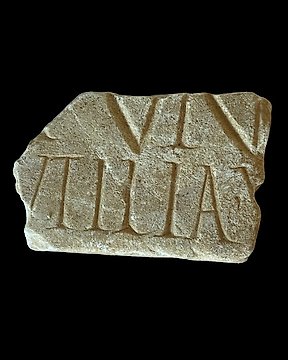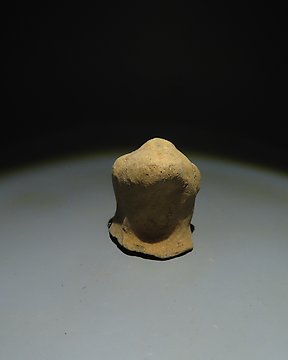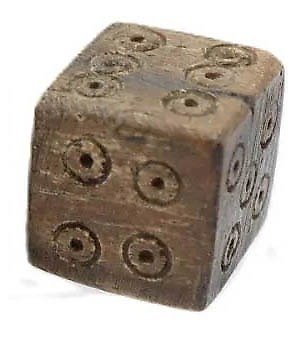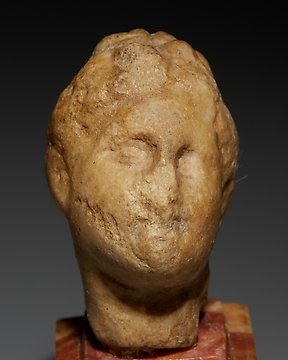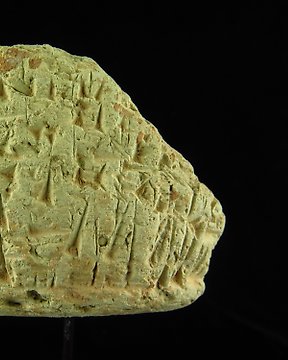Buenos días, señor. ¡Gracias por las precauciones de embalaje Tip / Top! Muy contento con mi compra. ¡Gracias!
Vizualizați traducereaEpoca Romanilor Marmură Sculptură a zeiței iubirii Afrodita - Venus cu Eros - Cupidon. 21,5 cm H. Licență de export
Nr. 84872069
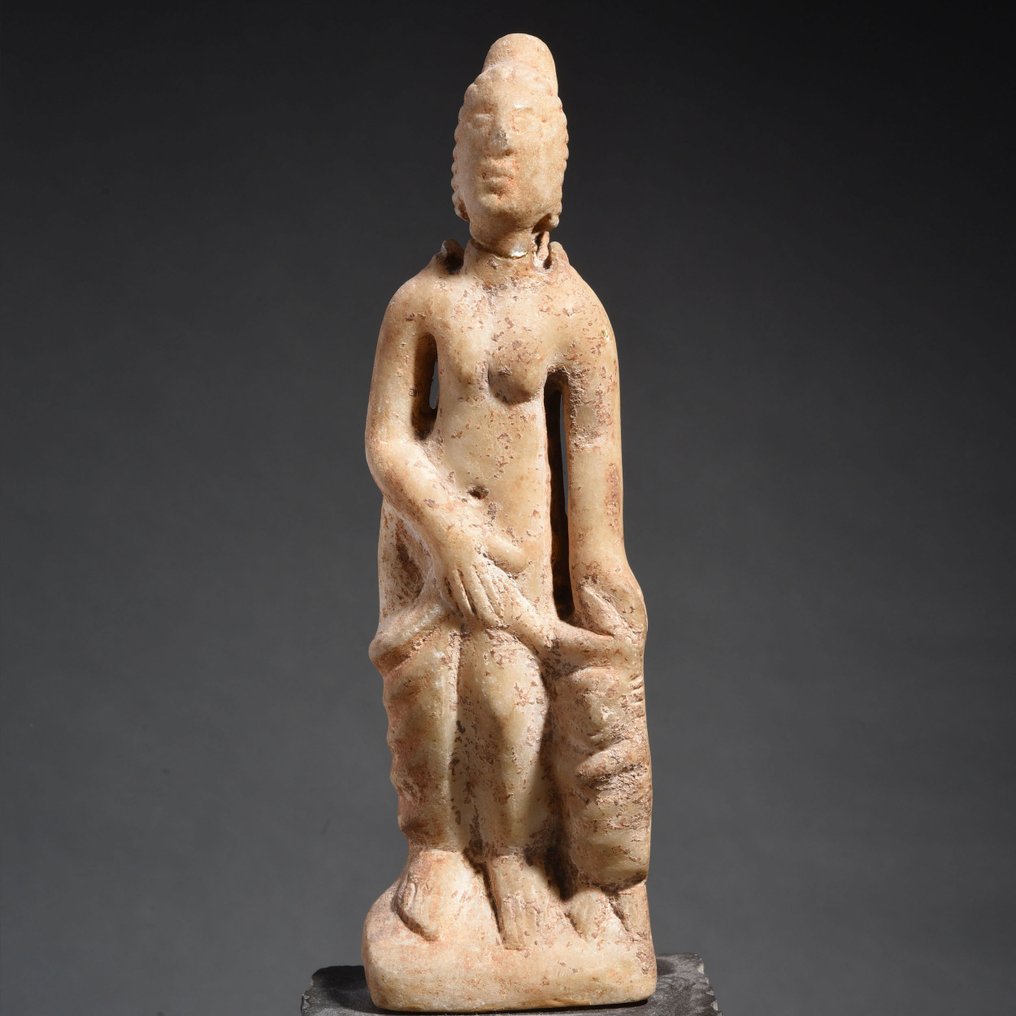
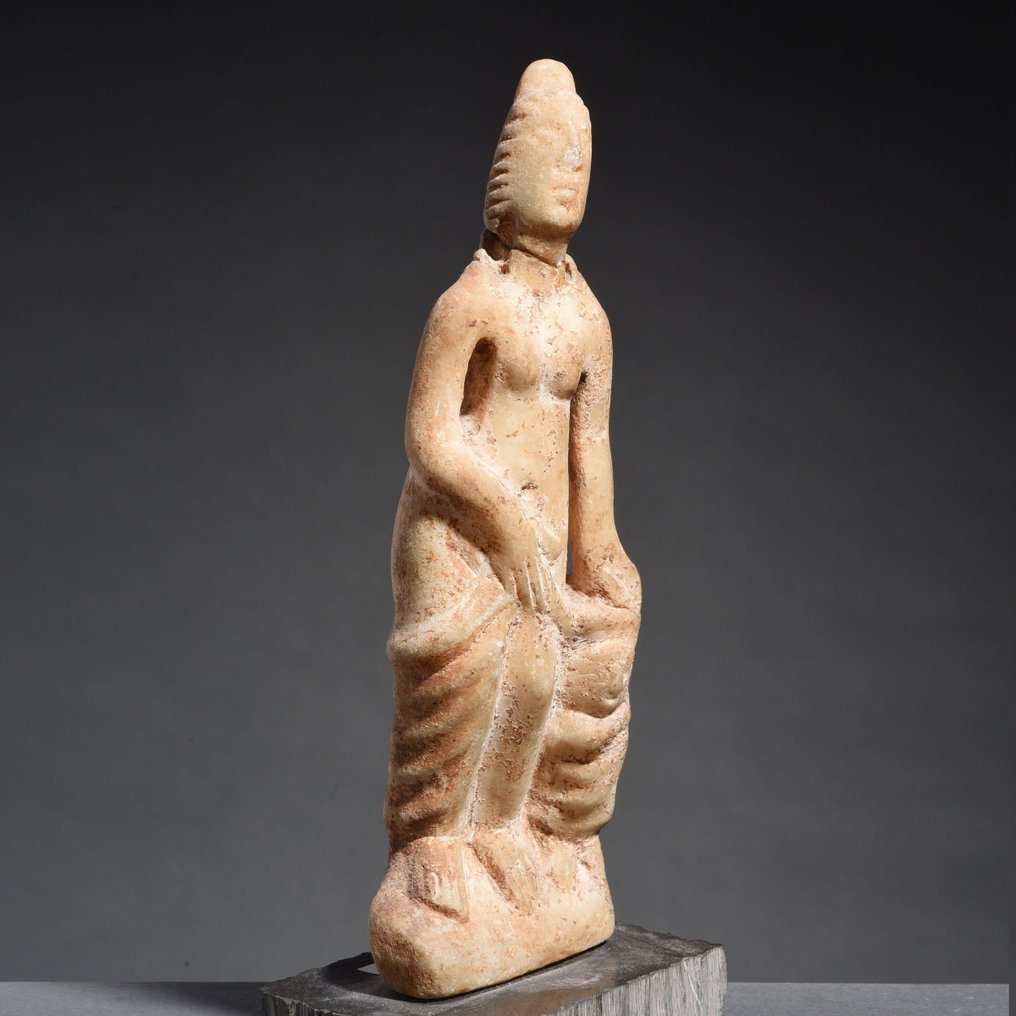
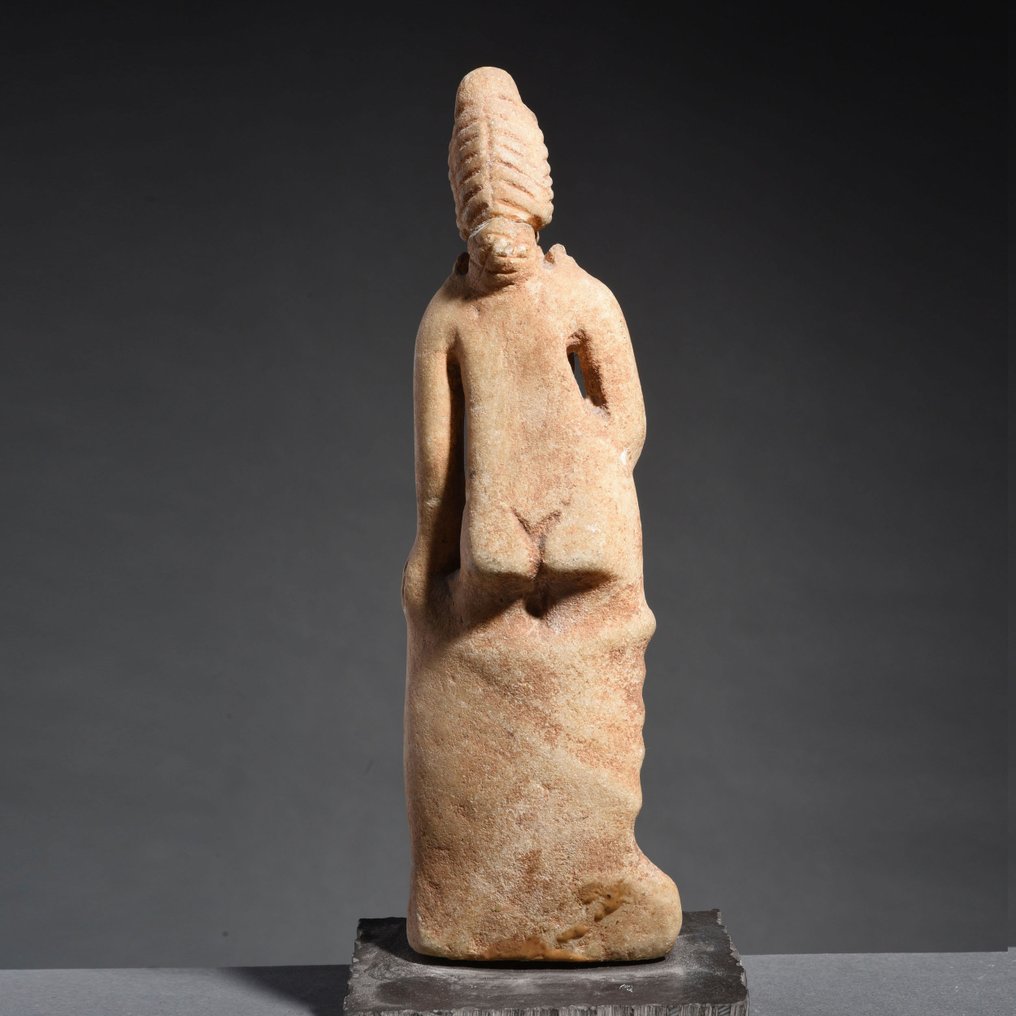
Sculpture of goddess of love Aphrodite - Venus with Eros.
Venus Chastising Cupid
Roman Empire, 1st - 3rd century AD
21,5 cm heigth and 23,5 cm height with stand.
PROVENANCE: Private collection, south of France, 1960 - 1970.
CONDITION: Repaired. A breakline in the neck of the goddess.
DESCRIPTION:
In this intimate sculptural portrayal of a relationship between two divinities, Aphrodite playfully threatens her mischievous son, Eros. The goddess of love wears a stephane--a crown--over her cascading hair and holds a folded cestus--a girdle--just above her shoulder, ready to slap her son. Eros--his wings fully extended--playfully holds up his hand to protect himself.
This scene represents a divine counterpart to the everyday closeness between a mortal mother and her son. During the Hellenistic era, gods and goddesses were often portrayed in a more personal way. This method of representation was a dramatic departure from the earlier Classical style, when the gods were represented more formally as gods, rather than as lighthearted--and humanlike--creatures.
Aphrodite was the goddess of beauty, love and fertility, embodying the primal forces of creation. From the 3rd century BC, she was identified with Venus by the Romans, their local divinity related to the same forces. The goddess, according to Hesiod, was born from foam – the sperm – in the surrounding sea which came from the cut-off genitals of Uranus. In the origins of the Universe, Uranus (the Heavens) mated with Gea (the Earth), engendering various children. But out of fear that they would take the throne from him, he kept them imprisoned in the body of their mother. Cronus, tired of this situation, managed to gain power, castrating his own father and throwing the genitals into the sea:
“From out of the foam a young woman was born. At first, she floated ashore towards the divine Cythera and from there she went to Cyprus… The august and beautiful goddess emerged from the sea, and around her delicate feet grew grass. (…) At first when she was born, and later when she went to join the body of the gods, Eros accompanied her as did the handsome Himeros. And she possessed these attributes (…): intimacy with young maidens, smiles, deceptions, sweet pleasure, love and tenderness.”
Eros, in Greek religion, god of love. In the Theogony of Hesiod (fl. 700 BCE), Eros was a primeval god, son of Chaos, the original primeval emptiness of the universe, but later tradition made him the son of Aphrodite, goddess of sexual love and beauty, by either Zeus (the king of the gods), Ares (god of war and of battle), or Hermes (divine messenger of the gods). Eros was a god not simply of passion but also of fertility. His brother was Anteros, the god of mutual love, who was sometimes described as his opponent. The chief associates of Eros were Pothos and Himeros (Longing and Desire). Later writers assumed the existence of a number of Erotes (like the several versions of the Roman Amor). In Alexandrian poetry he degenerated into a mischievous child. In Archaic art he was represented as a beautiful winged youth but tended to be made younger and younger until, by the Hellenistic period, he was an infant. His chief cult centre was at Thespiae in Boeotia, where the Erotidia were celebrated. He also shared a sanctuary with Aphrodite on the north wall of the Acropolis at Athens. Cupid, ancient Roman god of love in all its varieties, the counterpart of the Greek god Eros and the equivalent of Amor in Latin poetry. According to myth, Cupid was the son of Mercury, the winged messenger of the gods, and Venus, the goddess of love. He often appeared as a winged infant carrying a bow and a quiver of arrows whose wounds inspired love or passion in his every victim. He was sometimes portrayed wearing armour like that of Mars, the god of war, perhaps to suggest ironic parallels between warfare and romance or to symbolize the invincibility of love.
Notes:
- The piece includes authenticity certificate.
- The piece includes Spanish Export License (Passport for European Union) - If the piece is destined outside the European Union a substitution of the export permit should be requested, can take between 1-2 weeks maximum.
- The seller guarantees that he acquired this piece according to all national and international laws related to the ownership of cultural property. Provenance statement seen by Catawiki.
THE MINISTRY OF CULTURE FROM SPAIN ASKS ALL SELLERS FOR INVOICES OR OTHER DOCUMENTATION ABLE TO PROVE THE LEGALITY OF EACH ITEM BEFORE PROVIDING AN IMPORT OR EXPORT LICENSE.
#RomanCollection
#BarbieinspiredCollection.
Povestea Vânzătorului
Sculpture of goddess of love Aphrodite - Venus with Eros.
Venus Chastising Cupid
Roman Empire, 1st - 3rd century AD
21,5 cm heigth and 23,5 cm height with stand.
PROVENANCE: Private collection, south of France, 1960 - 1970.
CONDITION: Repaired. A breakline in the neck of the goddess.
DESCRIPTION:
In this intimate sculptural portrayal of a relationship between two divinities, Aphrodite playfully threatens her mischievous son, Eros. The goddess of love wears a stephane--a crown--over her cascading hair and holds a folded cestus--a girdle--just above her shoulder, ready to slap her son. Eros--his wings fully extended--playfully holds up his hand to protect himself.
This scene represents a divine counterpart to the everyday closeness between a mortal mother and her son. During the Hellenistic era, gods and goddesses were often portrayed in a more personal way. This method of representation was a dramatic departure from the earlier Classical style, when the gods were represented more formally as gods, rather than as lighthearted--and humanlike--creatures.
Aphrodite was the goddess of beauty, love and fertility, embodying the primal forces of creation. From the 3rd century BC, she was identified with Venus by the Romans, their local divinity related to the same forces. The goddess, according to Hesiod, was born from foam – the sperm – in the surrounding sea which came from the cut-off genitals of Uranus. In the origins of the Universe, Uranus (the Heavens) mated with Gea (the Earth), engendering various children. But out of fear that they would take the throne from him, he kept them imprisoned in the body of their mother. Cronus, tired of this situation, managed to gain power, castrating his own father and throwing the genitals into the sea:
“From out of the foam a young woman was born. At first, she floated ashore towards the divine Cythera and from there she went to Cyprus… The august and beautiful goddess emerged from the sea, and around her delicate feet grew grass. (…) At first when she was born, and later when she went to join the body of the gods, Eros accompanied her as did the handsome Himeros. And she possessed these attributes (…): intimacy with young maidens, smiles, deceptions, sweet pleasure, love and tenderness.”
Eros, in Greek religion, god of love. In the Theogony of Hesiod (fl. 700 BCE), Eros was a primeval god, son of Chaos, the original primeval emptiness of the universe, but later tradition made him the son of Aphrodite, goddess of sexual love and beauty, by either Zeus (the king of the gods), Ares (god of war and of battle), or Hermes (divine messenger of the gods). Eros was a god not simply of passion but also of fertility. His brother was Anteros, the god of mutual love, who was sometimes described as his opponent. The chief associates of Eros were Pothos and Himeros (Longing and Desire). Later writers assumed the existence of a number of Erotes (like the several versions of the Roman Amor). In Alexandrian poetry he degenerated into a mischievous child. In Archaic art he was represented as a beautiful winged youth but tended to be made younger and younger until, by the Hellenistic period, he was an infant. His chief cult centre was at Thespiae in Boeotia, where the Erotidia were celebrated. He also shared a sanctuary with Aphrodite on the north wall of the Acropolis at Athens. Cupid, ancient Roman god of love in all its varieties, the counterpart of the Greek god Eros and the equivalent of Amor in Latin poetry. According to myth, Cupid was the son of Mercury, the winged messenger of the gods, and Venus, the goddess of love. He often appeared as a winged infant carrying a bow and a quiver of arrows whose wounds inspired love or passion in his every victim. He was sometimes portrayed wearing armour like that of Mars, the god of war, perhaps to suggest ironic parallels between warfare and romance or to symbolize the invincibility of love.
Notes:
- The piece includes authenticity certificate.
- The piece includes Spanish Export License (Passport for European Union) - If the piece is destined outside the European Union a substitution of the export permit should be requested, can take between 1-2 weeks maximum.
- The seller guarantees that he acquired this piece according to all national and international laws related to the ownership of cultural property. Provenance statement seen by Catawiki.
THE MINISTRY OF CULTURE FROM SPAIN ASKS ALL SELLERS FOR INVOICES OR OTHER DOCUMENTATION ABLE TO PROVE THE LEGALITY OF EACH ITEM BEFORE PROVIDING AN IMPORT OR EXPORT LICENSE.
#RomanCollection
#BarbieinspiredCollection.
Povestea Vânzătorului
- 751
- 7
- 0
Perfecto! :)
Vizualizați traducereaWunderbares Stück. Alles wie beschrieben. Hervorragender Kontakt.
Vizualizați traducereaExtremely rapid courrier service from Barcelona to Flanders, picture was nicely and carefully packaged. Muchas gracias!
Vizualizați traducereaVery fine specimen! Thanks.
Vizualizați traducereagoede foto's, goede omschrijving, goed verpakt en snel verzonden.
Vizualizați traducereamolto bello tutto ok
Vizualizați traducereaPezzo come da descrizione, davvero notevole. Venditore molto consigliato in quanto gentile e disponibile. spedizione molto veloce. Ottimo!
Vizualizați traducereaVenditore davvero ottimo e gentile. Merce come da descrizione, spedizione veloce. Ottimo l'avere certificato di autenticità.
Vizualizați traducereaUn 100 como empresa un 100 como envío . Empresa muy especial con mucha exquisitez en todos los productos y en personal . Muchas gracias
Vizualizați traducereaAll well! Thanks.
Vizualizați traducereaVery nice and fine cut little jewel! Well packed too! Thanks!
Vizualizați traducereanice piece and very fast shipping!
Vizualizați traducereaEs una maravilla de moneda, donde se le nota los pasos de los años y me encanta. Servido muy rápido y bien empaquetado. Con su certificación. Qué más se puede pedir?
Vizualizați traducereaSnelle en correcte levering, alleen was de verpakking voor het schilderij niet stevig genoeg.
Vizualizați traducereaHerzlichen Dank!
Vizualizați traducereaAll OK and with very fast shipping.
Vizualizați traducereaPrachtig schilderij. Zo blij mee. Zeer nette verkoper en zeer snelle levering.
Vizualizați traducereaperfect ! very fast and high quality delivery !
Vizualizați traducereaAll well! Thanks.
Vizualizați traducereaVendeur très professionnel, top +++×
Vizualizați traducereaPhotos trop contrastées pour bien percevoir les défauts, mais ces défauts étaient visibles pour autant. Le "Bon état" est trompeur. Sinon, envoi rapide et correctement emballé. Frais de port exagérés.
Vizualizați traducereaGreat communication, delivery and product. Came with a well made certificate of authenticity and good packaging. Overall very happy with the purchase! Delivery is a bit expensive, but I recommend it
Vizualizați traducereaMagnifique témoin du passé, envoyé avec tous les justificatifs, impeccable. Encore une fois très satisfait, un grand merci
Vizualizați traducerea- 751
- 7
- 0
Buenos días, señor. ¡Gracias por las precauciones de embalaje Tip / Top! Muy contento con mi compra. ¡Gracias!
Vizualizați traducereaDeclinarea responsabilității
Vânzătorul garantează și poate dovedi că obiectul a fost obținut în mod legal. Vânzătorul a fost informat de către Catawiki că trebuie să furnizeze documentația cerută de legile și reglementările din țara de reședință. Vânzătorul garantează și are dreptul de a vinde/exporta acest obiect. Vânzătorul va furniza cumpărătorului toate informațiile disponibile cu privire la proveniența obiectului. Vânzătorul se asigură că toate autorizațiile necesare sunt/vor fi puse la punct. Vânzătorul va informa imediat cumpărătorul cu privire la eventualele întârzieri în obținerea unor astfel de autorizații.
Vânzătorul garantează și poate dovedi că obiectul a fost obținut în mod legal. Vânzătorul a fost informat de către Catawiki că trebuie să furnizeze documentația cerută de legile și reglementările din țara de reședință. Vânzătorul garantează și are dreptul de a vinde/exporta acest obiect. Vânzătorul va furniza cumpărătorului toate informațiile disponibile cu privire la proveniența obiectului. Vânzătorul se asigură că toate autorizațiile necesare sunt/vor fi puse la punct. Vânzătorul va informa imediat cumpărătorul cu privire la eventualele întârzieri în obținerea unor astfel de autorizații.
